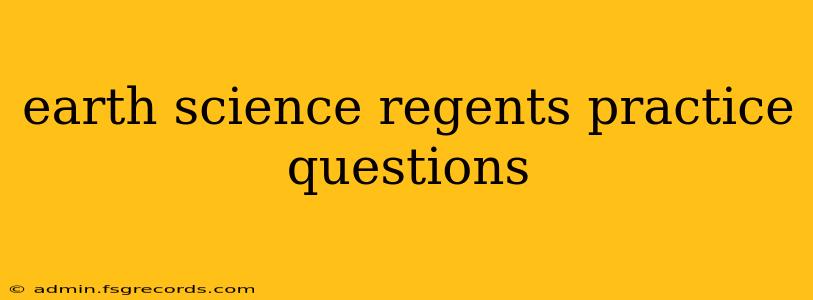Preparing for the Earth Science Regents exam can feel overwhelming, but with focused practice, you can significantly improve your score. This comprehensive guide provides a selection of practice questions covering key topics, along with detailed explanations to solidify your understanding. Remember to consult your textbook and class notes for a more thorough review.
Earth's Systems and Processes
1. Which process is primarily responsible for the formation of sedimentary rocks?
(a) Melting and solidification of magma (b) Metamorphism under high pressure and temperature (c) Weathering, erosion, deposition, and compaction of sediments (d) Crystallization of minerals from solution
Answer: (c) Sedimentary rocks are formed through the accumulation and lithification (compaction and cementation) of sediments derived from the weathering and erosion of pre-existing rocks.
2. What type of plate boundary is associated with the formation of mid-ocean ridges?
(a) Convergent boundary (b) Transform boundary (c) Divergent boundary (d) Subduction zone
Answer: (c) Mid-ocean ridges are formed at divergent plate boundaries where tectonic plates move apart, allowing magma to rise and create new oceanic crust.
3. The process by which water changes from a liquid to a gas is called:
(a) Condensation (b) Evaporation (c) Precipitation (d) Sublimation
Answer: (b) Evaporation is the phase transition of water from liquid to gas.
Weathering, Erosion, and Deposition
4. Which type of weathering involves the breakdown of rocks through chemical reactions?
(a) Mechanical weathering (b) Physical weathering (c) Chemical weathering (d) Biological weathering
Answer: (c) Chemical weathering alters the chemical composition of rocks, unlike mechanical weathering, which only changes their size and shape.
5. Glaciers are primarily agents of which type of erosion?
(a) Water erosion (b) Wind erosion (c) Ice erosion (d) Coastal erosion
Answer: (c) Glaciers are massive bodies of ice that carve out valleys and transport sediment through glacial erosion.
6. The process by which sediment settles out of a transporting medium is called:
(a) Erosion (b) Deposition (c) Weathering (d) Compaction
Answer: (b) Deposition occurs when the energy of the transporting medium (water, wind, ice) decreases, causing sediment to settle out.
Astronomy and Space Science
7. What is the primary source of energy for the Sun?
(a) Chemical reactions (b) Nuclear fission (c) Nuclear fusion (d) Gravitational collapse
Answer: (c) The Sun's energy is produced through nuclear fusion, where hydrogen atoms fuse to form helium, releasing enormous amounts of energy.
8. Which celestial body is located between Mars and Jupiter?
(a) Asteroid Belt (b) Kuiper Belt (c) Oort Cloud (d) Comet Belt
Answer: (a) The asteroid belt is a region of the solar system located between Mars and Jupiter containing numerous asteroids.
Mapping and Geographic Tools
9. What is the purpose of contour lines on a topographic map?
(a) To show the types of rocks present (b) To show elevation changes (c) To show political boundaries (d) To show drainage patterns
Answer: (b) Contour lines connect points of equal elevation on a topographic map, indicating the shape and slope of the land.
Tips for Success
- Review regularly: Consistent review of your notes and textbook will reinforce concepts.
- Practice, practice, practice: The more questions you answer, the better prepared you'll be.
- Identify your weaknesses: Focus your study time on areas where you struggle.
- Understand the concepts, not just memorize: Focus on grasping the underlying principles.
- Use diagrams and visual aids: Visual aids can help you understand complex concepts.
This is just a small sample of the types of questions you might encounter on the Earth Science Regents exam. By practicing regularly and focusing on understanding the fundamental principles, you will be well on your way to achieving a high score! Remember to consult your teacher or textbook for further practice questions and review materials.

